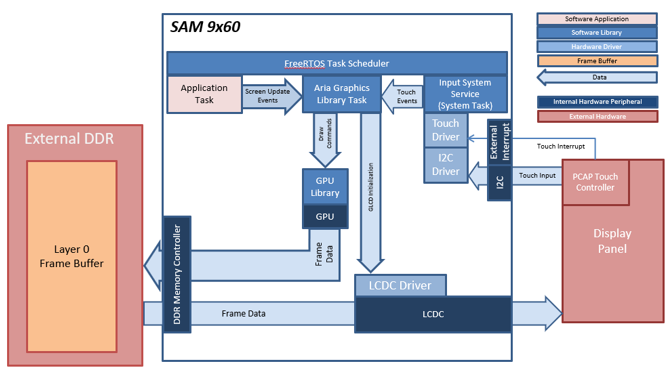
This is the FreeRTOS configuration that runs on the SAM 9x60 Evaluation Kit and WQVGA display.
The Graphics Library runs as stand-alone task, fully-blocking and waiting for events from external tasks like system service task or the application task. The Graphics Library uses the GFX2D GPU to draw the 32-bit RGBA8888 frame in a frame buffer that is stored in the external DDR memory. The LCDC display controller uses the frame data from the framebuffer to refresh the contents of the display.
Thread-safe APIs for sending events to the Aria task are provided by the Aria RTOS extension library.
User touch input on the display panel is received thru the PCAP capacitive touch controller, which sends a notification to the Touch Input Driver. The Touch Input Driver reads the touch information over I2C and sends the touch event to the Graphics Library thru the Input System Service.
Demonstration Features
• Aria Graphics Library, with FreeRTOS extensions
• Input system service and touch driver
• Time system service, timer-counter peripheral library and driver
• LCDC display controller and GFX2D GPU
• 32-bit RGBA color frame buffer in external DDR memory
• I2C peripheral library and driver
• JPEG image stored in internal flash
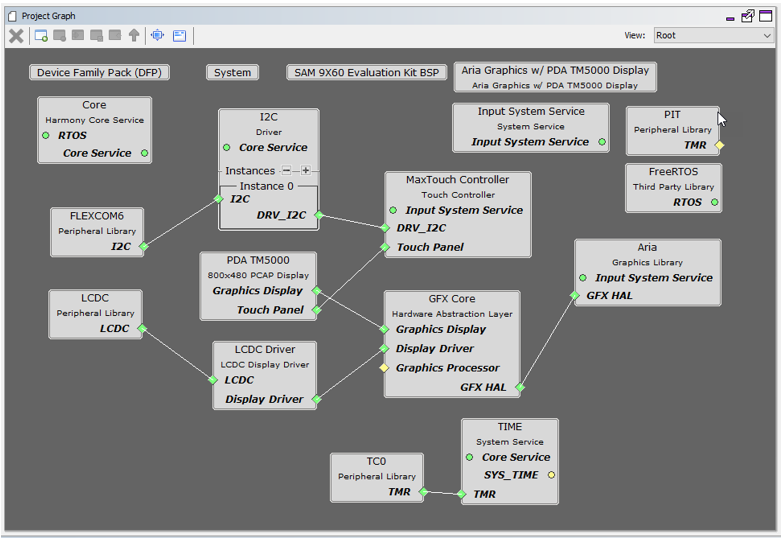
The Project Graph diagram shows the Harmony components that are included in this application. Lines between components are drawn to satisfy components that depend on a capability that another component provides.
Adding the “SAM 9x60 Evaluation Kit BSP” and “Aria Graphics w/ PDA TM5000 Display” Graphics Template component into the project graph will automatically add the components needed for a graphics project and resolve their dependencies. It will also configure the pins needed to drive the external peripherals like the display and the touch controller.
The FreeRTOS component is manually added to configure Harmony with FreeRTOS. Once FreeRTOS is added, the Aria Graphics RTOS extensions are automatically enabled.
To optimize for graphics, the Aria task priority is set at a higher priority 2.
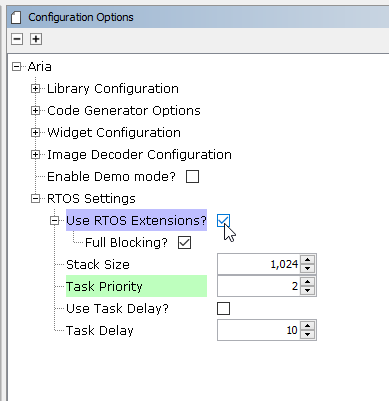
The Harmony Core Application is also configured to use a Task Delay of 10ms to allow other tasks to execute.

The parent directory for this application is gfx/apps/aria_quickstart. To build this application, using MPLAB X open the gfx/apps/aria_quickstart/firmware/aria_qs_9x60_ek_tm5000_freertos.X project file.
The following table lists configuration properties:
|
Project Name |
BSP Used |
Graphics Template Used |
Description |
|
aria_qs_9x60_ek_tm5000_freertos.X |
SAM 9x60 Evaluation Kit |
Aria Graphics w/ PDA TM5000 Display |
Aria GFX on SAM 9x60 Evaluation Kit Board and PDA TM5000 WVGA Display with FreeRTOS |
 Important! Important! |
This application may contain custom code that is marked by the comments // START OF CUSTOM CODE ... and // END OF CUSTOM CODE. When using the MPLAB Harmony Configurator to regenerate the application code, use the "ALL" merging strategy and do not remove or replace the custom code. |
Connect the ribbon cable from the display to the J16 connector on the back of the SAM 9x60 Evaluation Kit board.
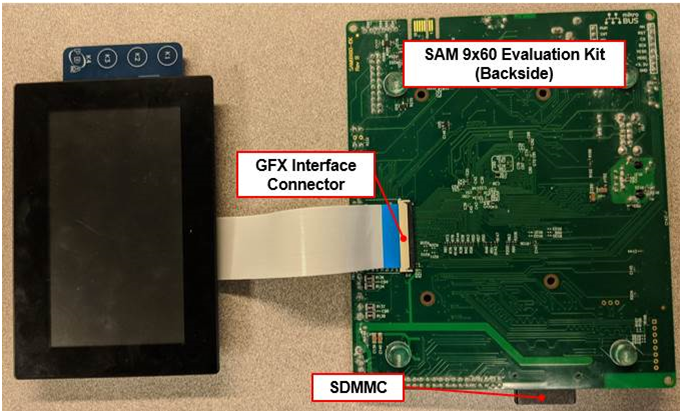
Power up the board by connecting the power adapter to power connector or a powered USB cable to the USB port on the SAM 9x60 Evaluation Kit board. The final hardware setup should be:

When power-on is successful, the demonstration will display a similar menu to that shown in the following figure (different configurations may have slight variation in the screen aspect ratio):
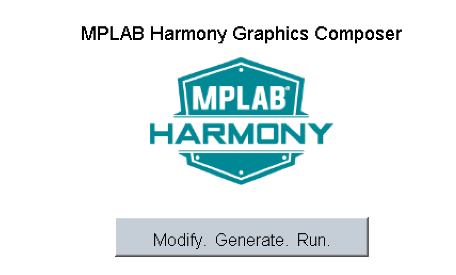
When Make changes. Generate. Run. is touched, the button will toggle with each individual touch.
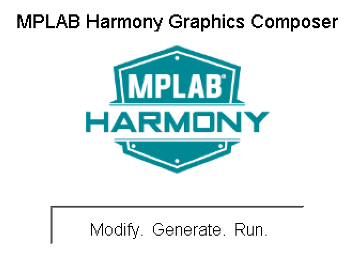
|
MPLAB® Harmony Graphics Suite
|